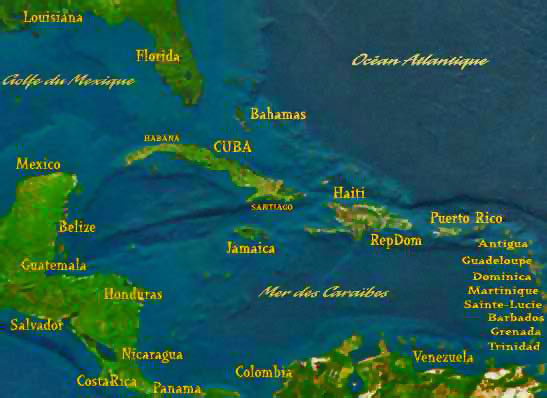
TERRITORY
The republic of Cuba is an archipelago formed by the island of Cuba, covering some 104,945 sq km, the Isla de la Juventud with 2 ,00 sq km and more than 4,200 cayos and small islands totaling 3,715 sq km.
Its total area is 110,860 sq km, at the entrance to the Gulf of Mexico in the Caribbean sea. Its neighbours : the Florida (USA) Peninsula, 180 km north; Jamaica, 140 km south; Haití, 77 km east and the Yucatan (México), Peninsula 210 km west.
POPULATION 11 251 000
The population growth rate is 1,2 per 100 inhabitants and a density of 99 inhabitants per sq km. Since the early 90's, the number of elders has increased. Cubans aged more than 65 now represent 12% of the population. Ethnic groups : Mulatos (mestizos or mixed) 51 %, Caucasian 37 %, Afro-Cubans 11 %, Chinese 1 %.
CAPITAL
La Habana, pop. 2 190 300
Principal cities
Santiago de Cuba 411 100, Camagüey 304 500, Holguín 263 300, Guantánamo 222 300, Santa Clara 216 000, Cienfuegos 153 300, Bayamo 152 000, Pinar del Río 146 100, Las Tunas 141 300, Matanzas 128 600, Ciego de Avila 113 600, Manzanillo 109 300 and Sancti Spiritus 105 700.
Cuba lists poblados, small towns of 200 to 2 000 inhabitants (moradores) : the province of La Habana has some 150 poblados ;
some 300 pueblos, with populations varying from 2 000 to 20 000 people of which 30 are located in the province of La Habana ;
and 50 ciudades (cities), 14 of which count more than 100,000 citizens.
Official language Español
Official currency
Peso cubano (approx. 27 pesos for $1US). Since November 2004, the peso convertible (cuc) is the official currency, replacing the US dollar for goods and services purchased by visitors.
POLITICAL REGIME
Socialist republic (Constitution : 1976).
Legislative power
National Assembly of the People, "del Poder Popular " : 589 elected members with five-year mandates, each representing a district. Voting rights begin at the age of 16. The 14 provinces each have an assembly whose members are elected by public suffrage, as are the 169 members of municipal assemblies. President of the National Assembly
Ricardo Alarcón Quesada
CONSEJO DE ESTADO (State Council)
Presidente
Miguel Díaz-Canel
Primer Vice-presidente
Salvador Antonio Valdés Mesa
Vice-presidentes del Consejo de Estado (2018-2023)
• Ramiro Valdés Menendez
• Roberto Morales Ojeda
• Gladys Maria Bejerano Portela
• Ines Maria Chapman Waugh
• Beatriz Johnson Urrutia
• Homero Acosta Alvarez
Members of the State Council (2018-2023)
• Leopoldo Cintra Frias
• Teresa Maria Amarelle Boué
• Ulises Guilarte de Nacimiento
• Miriam Nicado Garcia
• Guillermo Garcia Frias
• Bruno Eduardo Rodriguez Parilla
• Martha del Carmen Mesa
• Carlos Rafael Miranda Martinez
• Susely Morfa Gonzalez
• Rafael Ramon Santiesteban Pozo
• Miguel Angel Barnet Lanza
• Ileana Amparo Flores Morales
• Raul Alejandro Palmero Fernandez
• Jorge Berlanga Acosta
• Yipsi Moreno Gonzalez
• Elizabeth Peña Turuellas
• Yoerky Sanchez Cuellar
• Ivis Niulba Villa Milan
• Barbara Alexis Terry Depestre
• Reina Salermo Escalona
• Rosalina Fournier Frometa
• Carlos Alberto Martinez Blanco
• Felicia Martinez Suarez
PROVINCES
Pinar del Río, Artemisa, Mayabeque, Ciudad de La Habana, Matanzas, Cienfuegos, Villa Clara, Sancti Spíritus, Ciego de Ávila, Camagüey, Las Tunas, Holguín, Granma, Santiago de Cuba and Guantánamo, as well as the "Municipio Especial " de la Isla de la Juventud.
MAIN INDUSTRIES
Tourism, cigars, coffee, citrus fruits, rum, fishing, níckel, chrome, manganese, biotechnology and pharmaceutical research.
GNP
Gross national product : 7.1 billion dollars
GNP per capita : 650 dollars
RELIGIONS
Catholic, protestant and animist-afrocuban (Santería, Palo Monte and Abakuá).
CLIMATE
Insular sub-tropical. The hottest month is July, average temperature of 28°C ; coldest is January at 21°C. Average yearly temperature is 25.5°C. Relative humidity is 78%. The rainy season extends from May to October.
MOUNTAINOUS ZONES
Sierra Maestra, Macizo Sagua Baracoa, Sierra de Escambray and the Cordillera de Guaniguanico. Pico Turquino, in the Sierra Maestra, at 1974 meters, is the highest peak in Cuba.
RIVERS
Longest is the Cauto : 370 km. The largest is the Toa.
BEACHES 289. Kilometers of coast : 5,746
HEALTH
Unique in Latin America latine,the health network the whole of the territory and is government run and free for all : exams, care, operations, medication.
Cuba the smallest death rate for children in Latin America and one of the lowest in the world : 6,3 per one thousand births. Life expectancy is 77 years.
There are some 42,634 practicing doctors, a rate of one for 165 ; 7,515 stomatologists (1 for 524), 120,000 nurses, technicians and medical assistants ; 15,142 family doctors cover 87,6% of the population. Cuba has 80,781 beds in its hospital and medical centers.
Medical personnel work in 436 polyclinics, 284 hospitals, 166 stomatology clinics, 227 maternity wards and 197 homes for the elderly.
Source : one.cu
|
|
|
|
|
|
José Marti
|
|
|
|
Manuel de Cespedes
|
|
|
|
Mariana Grajales
|
|
|
|
Antonio Maceo
|
|
|
|
Fidel Castro Ruz
|
|
|
|
Celia Sanchez
|
|
|
|
Frank Pais
|
|
|
|
Haydée Santamaria
|
|
|
|
Camilo Cienfuegos
|
|
|
|
Vilma Espin
|
|
|
|
Violeta Casal
|
COST OF LIVING
Compare figures between Havana and Los Angeles (California).
HERE
|
© sogestour • Updated 29.08.2018

|